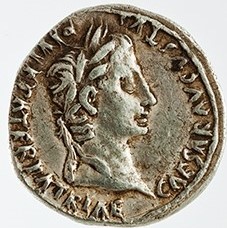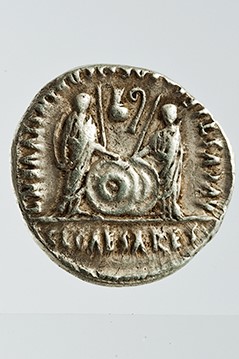Acquisition number: 1982.02
Obv.: Head of Augustus, laureate, r. CAESAR AVGVSTVS DIVI F(ilius) PATER PATRIAE.
Rev.: Gaius Caesar and Lucius Caesar, togate (wearing a toga), standing facing, each with hand on a shield; spear behind each shield. In field, simpulum (ceremonial ladle) to left and lituus (augur's staff) to right. C. L. CAESARES (in exergue); AVGVSTI F(ilii) COS.DESIG(nati) PRINC(ipes) IVVENT(tutis) (right to left).
Title: Denarius of Augustus - 1982.02
Acquisition number: 1982.02
Author or editor: Beryl Rawson
Culture or period: Roman Imperial
Date: 2 BC - AD 2
Material: Metal - Silver
Object type: Coins - Roman
Dimensions: 19mm (w)
Origin region or location: France
Origin city: Lugdunum
Display case or on loan: 5
Keywords: Coin, denarius, Roman, Imperial, Augustus, Gaius Caesar, Lucius Caesar, Lugdunum, Roman Gaul
Sear, D.R., Roman Coins and their Values 5 vols (London, Spink, 2000-2014) 1578; Mattingly, H., E.A. Sydenham, C.H. Sutherland, R.A. Carson, The Roman Imperial Coinage 13 vols (London, Spink, 1923-1994) (Sutherland) 207 pl.4; Mattingly, H.,Coins of the Roman Empire in the British Museum, 6 vols (London, 1965) 513; Giard, J.-P., Catalogue des Monnaies de l’Empire Romain 3 vols (Paris: Bibliothèque Nationale, 1988-1998) 1648.
1982.02
Denarius of Augustus
3.65 g. 2 BC–AD 2. Lugdunum
Obv.: Head of Augustus, laureate, r. CAESAR AVGVSTVS DIVI F(ilius) PATER PATRIAE.
Rev.: Gaius Caesar and Lucius Caesar, togate (wearing a toga), standing facing, each with hand on a shield; spear behind each shield. In field, simpulum (ceremonial ladle) to left and lituus (augur's staff) to right. C. L. CAESARES (in exergue); AVGVSTI F(ilii) COS.DESIG(nati) PRINC(ipes) IVVENT(tutis) (right to left).
This coin can be dated to a narrow period, between 2 BC, when Augustus received the title pater patriae (father of the fatherland) and Lucius Caesar became a consul designate, and AD 2, when Lucius Caesar died. Some authorities extend the latter date, in spite of Lucius’ death and although Gaius Caesar held an actual consulship in AD 1 after a period as suffect (replacement) consul, on the grounds that the coins and the idea of a dynasty continued to be advertised.
C. and L. Caesar were sons of Agrippa and Augustus’ daughter Julia, born 20 BC and 17 BC respectively. In 17 BC Augustus adopted these grandsons as his own sons, C. Iulius Caesar and L. Iulius Caesar. From an early age they were introduced into public life and groomed as possible successors to Augustus. In 13 BC they appeared on Roman coinage with their mother Julia, clearly signifying a dynasty. They played a leading role in public ritual such as the Trojan Games, which involved boys and adolescents, and after they had turned fourteen they were each given the title of princeps iuuentutis, ‘leader of youth’, by the assembled body of the equites (equestrians): Gaius in 5 BC and Lucius in 2 BC. In each of those years, they received silver shields and spears from the equites. At that age they each were designated to a consulship, to be held after a gap of five years (when they would still be well under the normal minimum age for the consulship under Augustus of 31). These honours are recorded by Augustus in his Res Gestae 14.
The simpulum (ceremonial ladle) and lituus (augur's staff) were tokens of priesthood (Gaius was pontifex and Lucius augur).
Sear, D.R., Roman Coins and their Values 5 vols (London, Spink, 2000-2014) 1578; Mattingly, H., E.A. Sydenham, C.H. Sutherland, R.A. Carson, The Roman Imperial Coinage 13 vols (London, Spink, 1923-1994) (Sutherland) 207 pl.4; Mattingly, H.,Coins of the Roman Empire in the British Museum, 6 vols (London, 1965) 513; Giard, J.-P., Catalogue des Monnaies de l’Empire Romain 3 vols (Paris: Bibliothèque Nationale, 1988-1998) 1648.

